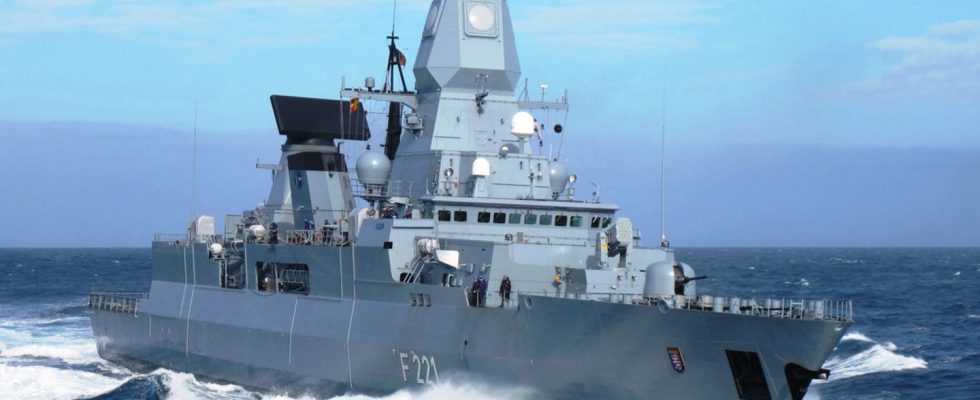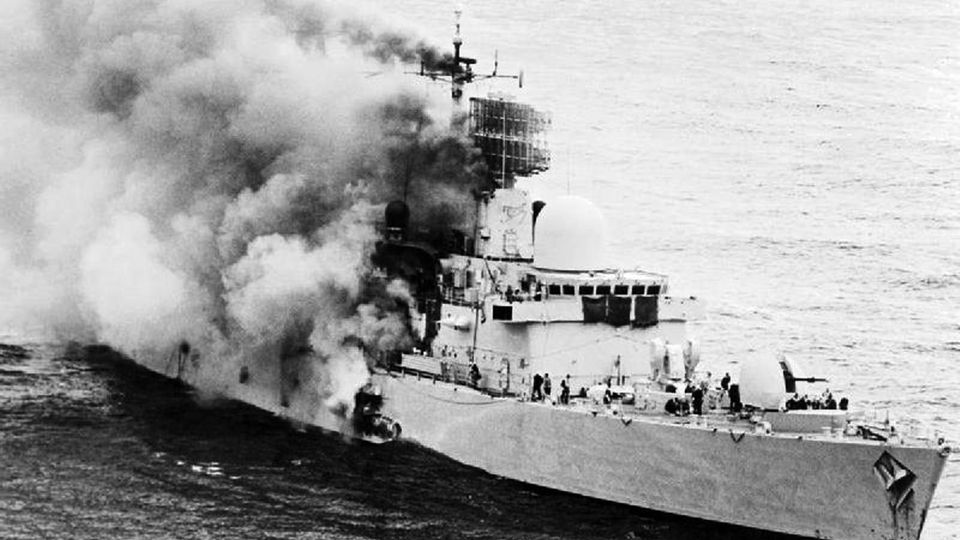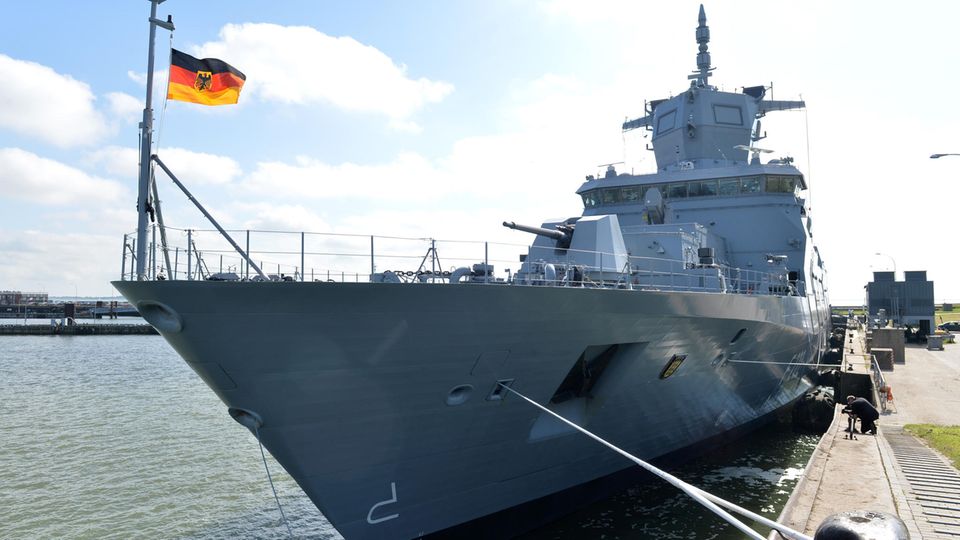analysis
Operation against Houthi rebels
Frigate “Hessen”: This is how the German Navy becomes a laughingstock
The “Hessen” has an ammunition problem.
© German Navy
First a US drone was attacked and now the “Hesse” is in danger of running out of ammunition. Even if the crew did everything right, the operation is already a PR disaster.
With great words the frigate was “Hesse”, their baptism of fire then developed into an international laughing stock. Two rockets were fired at an ally’s drone. The drone remained intact, but both rockets “failed”. Afterwards, two of the Houthis’ drones were shot down, but the PR Damage had already occurred.
It is not yet possible to judge from the outside how fatal the first operation was. If you go through the events, the following picture emerges.
US drone not detected
An ally’s missile was moving over the operational area and the German frigate was neither informed nor could it use its electronic means to recognize that it was a US drone of the standard Reaper type. Neither of these reflects well on the mission, regardless of who is “to blame”. Today, networking decides the battle, the collection, evaluation and exchange of data. And all of this in the present time. But the “Hesse” is not equipped with the US’s electronic Aegis system, so it cannot be fully integrated into a US-led association. The commander of a US Arleigh Burke-class destroyer does not have 30 seconds to detect and intercept an attacking Houthi missile; for diving drones, the time between detection and impact can be similarly long. There’s no time to pick up the phone. If the Houthis release entire swarms of drones and missiles, it must not be the case that the “Hessians” can only see a chaos of targets in the air and then have to guess which side they belong to. However, this is a special case because it was a US drone that had nothing to do with the naval operation and was not reported.
Unclear process
Two shots, two misses would be just as big a problem. If so. The Allies, including the Hessians, send two defensive missiles at every attacker. The double use increases the kill probability to over 90 percent. However, this assumes that the rockets function properly. If this is not reliably the case, the entire bet becomes a game of chance and would have to be canceled immediately. However, it is conceivable that the missile’s targeting system recognized the Reaper’s profile and intentionally missed the “friendly” target.
Ship without ammunition
Apparently the defensive missiles for the “Hesse” are only available in a limited number. The “Hesse” uses three types of defense missiles. For close range there is the RIM-116 RAM (Rolling Airframe Missile). It can only protect the frigate itself and represents the last line of defense. When it is used, something has already gone very wrong. For more distant air targets there are the Standard Missile 2 (SM-2) and the RIM-162 Evolved Sea Sparrow. Fleet Admiral Axel Schulz, to whom the “Hessen” reports, had to admit that supplies could only be delivered from German depots for one of the three types of rockets on board. And only to a small extent. This is typical of the Bundeswehr’s shortage economy. No type of weapon is designed for a long war; the supply of ammunition of each type is usually sufficient for barely more than three days of major combat. The “Hessen” has 32 long-range rockets in its launchers. If they are used up or are just running low, the mission is over. Maybe a handful of rockets can still be added.
False war for the ship
That will hardly be enough against the Houthis. They catch not only the “Hessians” but every navy off guard. The Sachsen class was built for air defense. But when building in the noughties, people imagined something completely different under the threat of air. Ships like the “Hessen” were intended to protect a larger unit, for example with an aircraft carrier, from attacks in the air. In a type of modern naval battle in which Russian cruisers or jets would attempt to wrest control of the Atlantic from the West. These battles would have been highly intense but short. Either the enemy would have sunk their own ship or would have lost their strength in the attempt.
Attrition by the Houthis
The Houthis are forcing a fight on the frigate that is extremely unfavorable to them. The main task is to protect shipping in the Red Sea. To do this, the “Hesse” must be close to the coast, a situation that the captain should avoid. And it not only has to intercept drones or missiles that target the “Hesse” and other combat ships, but also those that attack merchant ships. This puts “Hesse” in a loose situation from the start. The Houthis have offensive weapons of varying quality. The “Hesse” and other Allied ships have to use their scarce and expensive missiles even if the Houthis attack a merchant ship with the simplest cheap drone. You can ignore the money, but every time an aircraft powered by a better moped engine takes off, the supply of defense missiles decreases by two. And the “Hessen” originally only had 32 on board. In a sea battle, one would be happy if the frigate had survived a battle and was then fully re-armed. At some point, the supply of missiles in the Horn of Africa will simply run out. And the Houthis can also count. If the “Hesse” supply runs out, the ship would be a worthwhile target for a swarm attack.
War is decided on land
The ammunition disaster sheds a telling and unfavorable light on the non-existent war capability of the entire Bundeswehr, especially given the fact that a military confrontation with Russia can no longer be ruled out. The SM-2 can in principle be procured by the USA. Unfortunately, the USA is facing the same problem as us: its expensive missiles are being exhausted by Brummer drones. Even if supplies are larger, that doesn’t mean you can easily shop for the SM-2 in the US. The battle for access to the Red Sea cannot be won by the “protective” ships. They only have a chance of success if air strikes succeed in destroying the Houthis’ military structures. It is doubtful whether this will work. Houthi weapons are often assembled in Yemen. The required components were smuggled into the country on small boats. Drone production in backyard workshops is likely to far exceed the ability of industrialized Germany to build defense missiles.
Image corrupted
The deployment of the “Hesse” will put a strain on the Bundeswehr as a whole. It is impossible to explain to the population why a ship that cost over 1.3 billion is hardly usable because of the lack of missiles. Whether the German Navy or the Bundeswehr, the German armed forces are the “paper tiger” that Mao Zedong once spoke of. In order to create the much-vaunted military capability, trust in the leadership is a basic requirement. Whether you see the “Hesse” incident as a laughing stock or a bereavement, the Bundeswehr cannot afford such mistakes.





